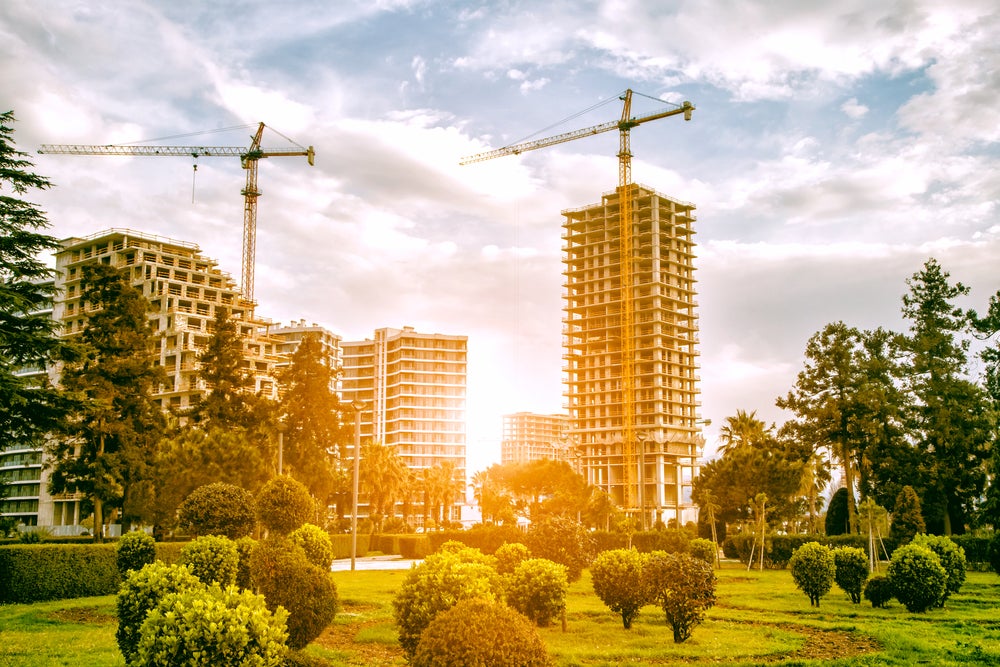
Rapidly increasing investment in sustainable construction is creating a new ecosystem of green construction technology companies. According to GlobalData research, venture capital (VC) investment in green construction saw a significant rise in 2022, reaching $115m from just $6.9m in 2021 – signalling the sector’s expected growth in the next decade.
According to GlobalData, green construction VC deal volume also increased tenfold in 2022.
The creation of green construction technology companies is being driven by a growing global focus on green construction methods to fulfil sustainability goals. The World Green Building Council estimates that the energy required to construct and operate buildings accounts for around 40% of global carbon emissions. This collective problem is the driver for the development of a green construction start-up ecosystem. Start-ups in the space are focused on varying activities, from the design and construction of low-carbon buildings to sustainable building materials companies, as well as manufacturers of prefabricated building components.
A November 2022 study titled the Future of Building in a Low-Carbon World, carried out by VC firm A/O PropTech, reflects this surge in VC investment, finding that low-carbon building practices attracted record levels of VC funding in 2022, with investment soaring to $2.2bn, according to A/O PropTech’s own research, which accounts for a broad range of green construction activity.
A/O PropTech found that $4.5bn of early stage capital was invested in companies directly focusing on decarbonising the architecture, engineering and construction sectors between 2017 and 2022, involving more than 452 deals. While 80% of the total investment value over that period was concentrated in North American start-ups, more than half of the deals done were in Europe. London was the leading city for overall deal volume. While deal volume is increasing in Europe, and particularly London, the capital value is still, by far, weighted towards the US, says A/O PropTech founder Gregory Dewerpe.
Dewerpe says clear regulations coming from Europe will, over time, create a significant risk to property assets. “This is a trending risk,” he says, in addition to customer pressure in the market today. “If owners in the property industry, for example, want the best tenants they will need to demonstrate their own net-zero commitments,” he adds.
The EU has a mandate to start looking at embodied carbon (which is all the carbon dioxide emitted in producing construction materials as well as construction itself), but countries are taking very different regulatory approaches. Dewerpe says A/O PropTech’s report identified Denmark, France and the Netherlands as being far ahead of larger countries such as the UK and Germany, which are actually quite far ahead in terms of retrofitting regulations but less advanced for new construction. “So, there is a kind of gap there,” he adds.
In 2022, there was also a shift to slightly later stages of VC investment in start-ups, which suggests that parts of the low-carbon construction segments are maturing. Close to 40% of deals in 2022 were estimated to be pre-seed and seed, compared with more than 80% in 2017. Larger-value, later-stage deals increased to nearly 50% in 2022, up from 10% in 2017.
What is driving green construction investment?
The increased investment in green construction technologies is a combination of several factors, says GlobalData associate analyst Robert Penman. “Technological innovation from other sectors, notably manufacturing, is spilling over to the construction sector, both expanding the possible use cases and increasing affordability,” he says. “This includes the use of new materials, production techniques such as 3D printing and uptake of artificial intelligence to improve efficiency and reduce waste.” In addition, start-ups and investors are realising the vast improvements that these innovations can bring to the construction industry, adds Penman.
However, he cautions that although the rapid investment growth in green construction technologies (albeit from a low base) is promising, an uphill battle may follow to ensure the industry is looking for and accepts new solutions. “Success will be determined by technology vendors providing solutions that can be easily applied in existing business models,” says Penman. “More investment will be required to ensure solutions have a low upfront cost and can be scaled rapidly.”
Alongside technology advances, increased global regulation in the construction industry is said to be driving investment. The UN 2030 Agenda for Sustainable Development has been attributed as playing an influential role in the growth of more environmentally friendly construction. According to GlobalData, much of the sector’s growth is expected to come from developing nations. The top five countries leading the green construction market are China, the US, India, Mexico and Indonesia. In 2021, China was the leading green building market, valued at $178.1m, up 10.4% compared with 2020. This was followed by the US, which ranked second at $83.1bn, up 10.8% compared with 2020, while the other three markets (India, Mexico, and Indonesia) had a cumulative market value of $58.5m in 2021.
The innovation seen within the green construction industry in 2022 has both the potential to make major sustainability improvements after years of slow progress and has a requirement to do so over the next decade in the face of increasing scrutiny, according to Penman. By all accounts, sustainable construction is a sector that is likely to build on 2022’s momentum and see much progress in the coming year.
Credit: Source link


Comments are closed.